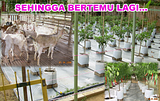Fodder
From Wikipedia, the free encyclopedia
( http://en.wikipedia.org/wiki/Fodder )
Fodder factory set up by an individual farmer to produce customized cattle feed
In agriculture, fodder or animal feed is any foodstuff that is used specifically to feed domesticated livestock, such as cattle, goats, sheep, horses, chickens and pigs. Most animal feed is from plants but some is of animal origin. "Fodder" refers particularly to food given to the animals (including plants cut and carried to them), rather than that which they forage for themselves (see forage). It includes hay, straw, silage, compressed and pelleted feeds, oils and mixed rations, and also sprouted grains and legumes.
The worldwide animal feed industry consumed 635 million tons of feed (compound feed equivalent) in 2006, with an annual growth rate of about 2%. The use of agricultural land to grow feed rather than human food can be controversial; some types of feed, such as corn (maize), can also serve as human food, while others such as grass cannot. Some agricultural by-products which are fed to animals may be considered unsavory by human consumers.
Common plants specifically grown for fodder
From Wikipedia, the free encyclopedia
( http://en.wikipedia.org/wiki/Fodder )
Fodder factory set up by an individual farmer to produce customized cattle feed
In agriculture, fodder or animal feed is any foodstuff that is used specifically to feed domesticated livestock, such as cattle, goats, sheep, horses, chickens and pigs. Most animal feed is from plants but some is of animal origin. "Fodder" refers particularly to food given to the animals (including plants cut and carried to them), rather than that which they forage for themselves (see forage). It includes hay, straw, silage, compressed and pelleted feeds, oils and mixed rations, and also sprouted grains and legumes.
The worldwide animal feed industry consumed 635 million tons of feed (compound feed equivalent) in 2006, with an annual growth rate of about 2%. The use of agricultural land to grow feed rather than human food can be controversial; some types of feed, such as corn (maize), can also serve as human food, while others such as grass cannot. Some agricultural by-products which are fed to animals may be considered unsavory by human consumers.
Common plants specifically grown for fodder
Round hay bales
Alfalfa (lucerne)
Barley
Birdsfoot trefoil
Brassicas
Chau moellier
Kale
Rapeseed (Canola)
Rutabaga (swede)
Turnip
Clover
Alsike clover
Red clover
Subterranean clover
White clover
Grass
False oat grass
Fescue
Bermuda grass
Brome
Heath grass
Meadow grasses (from naturally mixed grassland swards)
Orchard grass
Ryegrass
Timothy-grass
Maize (corn)
Millet
Oats
Sorghum
Soybeans
Trees (pollard tree shoots for "tree-hay")
Wheat
Types of fodder
various types of legume (left) and grass (right) fodder
Compound feed and premixes, often called pellets, nuts or (cattle) cake.
Crop residues: stover, copra, straw, chaff, sugar beet waste
Fish meal
Freshly cut grass and other forage plants
Meat and bone meal (now illegal in many areas due to risk of BSE)
Molasses
Oil cake and press cake
Oligosaccharides
Conserved forage plants: hay and silage
Seaweed
Seeds and grains, either whole or prepared by crushing, milling etc
Sprouted grains and legumes
Yeast extract
Health concerns
Barley is a crop sometimes grown for fodder
In the past, mad cow disease spread through the inclusion of ruminant meat and bone meal in cattle feed due to prion contamination. This practice is now banned in most countries where it has occurred. Some animals have a lower tolerance for spoiled or moldy fodder than others, and certain types of molds, toxins, or poisonous weeds inadvertently mixed into a food source may cause economic losses due to sickness or death of the animals.
Sprouted grains as fodder
Fodder in the form of sprouted grains and legumes can be grown in a small-scale environment. Sprouted grains can greatly increase the nutritional value of the grain compared with feeding the "raw" (ungerminated) grain to stock.












No comments:
Post a Comment